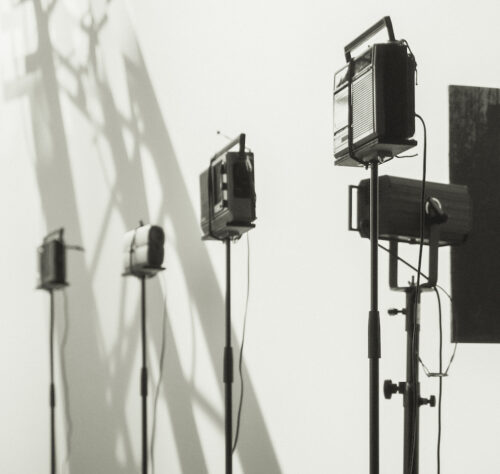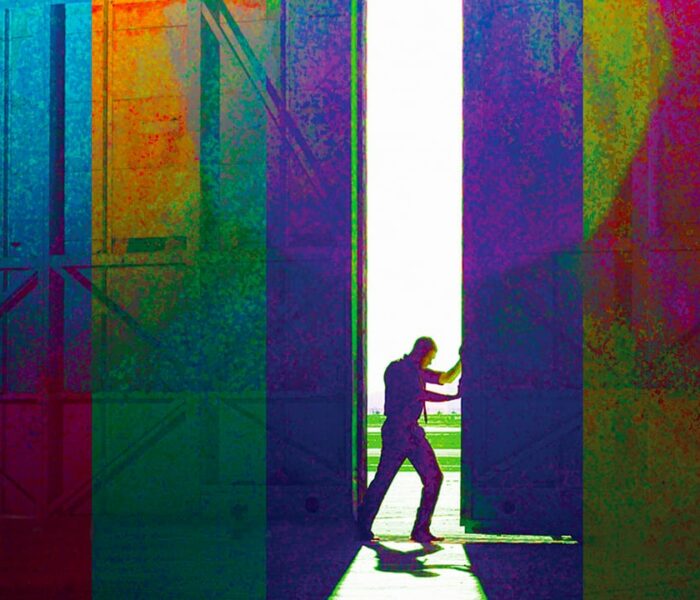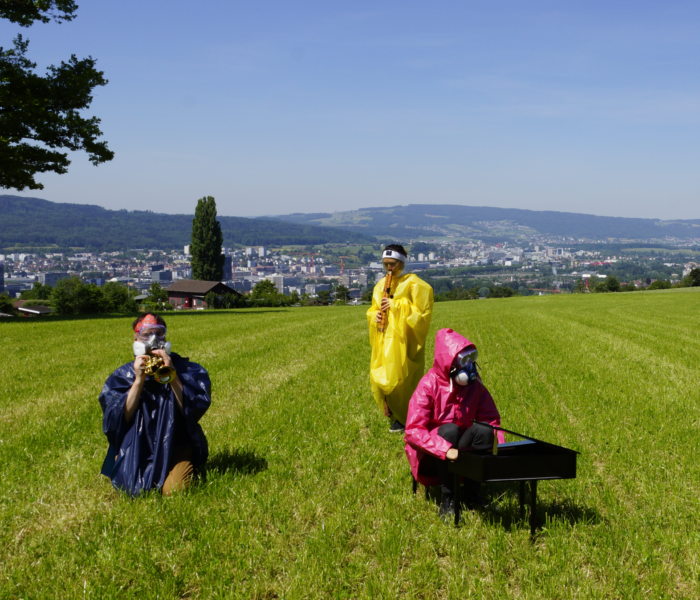Anne-Laure Pigache se passionne pour la voix et ses modes d’émission pluriels ; Anne-Julie Rollet ne fait rien sans son magnétophone qui constitue son instrument privilégié et une des sources sonores principales du duo qu’elle forme avec sa partenaire sous le nom des Harmoniques du Néon. Itinérants autant qu’originaux, leurs projets balancent entre l’installation et le concert, la création radiophonique et la performance. Avec la musique toujours au centre de la proposition, elles aiment rencontrer un contexte, faire vivre une situation, s’approprier un espace en explorant la transversalité des pratiques artistiques et le rapport à l’espace public.
Depuis quand la compagnie existe-t-elle?
Anne-Laure Pigache : depuis 2010, lorsque je fonde l’association Les Harmoniques du Néon pour y développer des projets autour de la voix, de la poésie sonore, de la musique improvisée et de la création radiophonique, domaines qui m’attachent plus particulièrement. Mon premier spectacle, Dyslexie, a été écrit en 2011, avec Pascal Thollet et Anne-Julie Rollet au traitement du son. Anne-Julie revient avec son magnétophone pour travailler avec nous en 2015 où elle anime des ateliers et nous montons un nouveau spectacle, Parlophonie, autour du traitement de la parole via l’enregistrement et la transformation en direct. Nous renouvelons notre collaboration avec installation et spectacle dans le cadre de la Biennale de Grame à Lyon, en 2018, et Anne-Julie devient artiste associée de la compagnie à ce moment-là.
PARLOPHONIE from anne laure pigache on Vimeo.
Quels sont vos parcours respectifs?
ALP : J’ai fait science-po à Grenoble durant quatre ans avant de trouver ma vocation dans le domaine artistique ; plutôt que de recommencer mes études, j’ai préféré me former sur le terrain à travers des stages et surtout des rencontres qui m’ont marquées ; une metteuse en scène russe Nika Kossenkova, des personnalités attachées à la poésie sonore (Phil Minton, Vincent Barras, Japp Blonk), à la musique concrète : le fil rouge était la voix, le travail autour des mots et la question de l’écoute.
Anne-Julie Rollet : Je suis quant à moi passionnée par le son fixé, une passion transmise par mes deux grands-pères qui faisaient des enregistrements, même si on avait tendance à m’éloigner d’un domaine qui ne cadrait pas avec ma condition de fille. Je n’en avais que plus de désir et j’ai fini par découvrir la musique concrète lors d’un concert du bruit de la bande au 102 à Grenoble où était joué sur un acousmonium (orchestre de haut-parleurs) Tabou de Michèle Bokanowski, une révélation quant au chemin à suivre. Je faisais en parallèle des études de sociologie qui allaient s’avérer complémentaires dans ma démarche sur le son et les expériences in situ.



L’appellation “Les harmoniques du Néon” met en interaction les sons et la lumière. Quels objectifs vous êtes-vous données précisément?
ALP et AJR : Pour nous, le néon est plutôt l’objet banal que l’on rencontre dans les lieux que l’on investit ; plus que la lumière, c’est l’endroit que l’on a choisi qui crée l’événement. Nous accordons toujours beaucoup d’importance au lieu dans lequel nous évoluons et à son histoire.
Quelles sont vos stratégies pour mettre en scène la musique?
AJR : Chacun de nos projets implique une situation nouvelle et un contexte nouveau au sein desquels la musique est toujours centrale. L’exemple le plus parlant est sans doute notre projet Vitrine qui consiste à jouer avec le quotidien d’une rue. On se sert de la vitrine d’un magasin comme un écran de cinéma renvoyant l’image d’une rue et son animation, sa pulsation, sa vibration sonore singulières. Anne-Laure est dans la rue avec un micro, le public est à l’intérieur, qui perçoit les événements sonores amplifiés voire transformés en direct par mes actions spécifiques : disons que nous musicalisons une situation.
Vitrine-Teaser from Les Harmoniques du Neon on Vimeo.
Est-ce là ce rapport à l’espace public dont vous parlez dans votre travail?
ALP et AJR : Nous cherchons à nous approprier des lieux, des espaces, aller écouter, capter des sons, des voix, des situations, considérant la parole comme lieu d’interaction entre l’intime et le social, le langage comme évènement sonore et musical. Ainsi avons-nous dernièrement posé nos micros sur une des places de Grenoble où dealent des jeunes gens, une manière de rentrer en contact avec eux de façon plus sensible, via le flux sonore et musical.
Y a-t-il des partitions qui s’écrivent, avant ou après la performance?
ALP et AJR : Nous avons une conduite, une intention musicale qui est notée, des modalités de jeu qui servent de balises et déterminent un cadre temporel. Dans le cas de Vitrine, déjà évoqué, on joue avec ce qui arrive, on laisse les incidents advenir ; les événements de la rue sont notre partition ; il faut être réactif à ce qui se passe. Nos partitions, qui sont déposées à la SACEM ou à la SACD, se présentent sous forme de protocoles ou règles de jeu dont le processus ne peut se déployer qu’in situ. Nous ne répétons jamais exactement le même spectacle d’un soir à l’autre.
Anne-Julie, vous êtes restée fidèle au magnétophone et au lo-fi ; comment travaillez-vous?
AJR : Je suis surtout attachée au son particulier, riche et chaleureux, de la bande que je préfère au signal numérique, ce qui ne m’empêche pas d’utiliser des outils numériques. Le frottement entre les deux, m’intéresse. Lors des performances, j’installe une boucle de bande magnétique sur mon revox B77 qui va tourner, capter le son produit par une source choisie et sur laquelle je vais intervenir par différentes manipulations. Ces traitements sont réalisés en direct, par le jeu sur la vitesse, avec le principe de l’accumulation et de l’incrustation d’éléments sonores. Puis je projette le son sur différents haut-parleurs qui sont pour moi également des instruments.
Écouter l'Ombre from Les Harmoniques du Neon on Vimeo.
Anne-Laure, avez-vous recours à des textes écrits lors de vos performances avec Anne-Julie?
ALP : J’ai commencé par écrire mes propres textes mais j’ai rapidement opté pour l’oralité, la parole de conversation qui ne nécessite pas d’écrit préalable. J’ai notamment travaillé avec Catherine Contour (chorégraphe) qui explore l’outil hypnotique pour la création. Cet état de conscience permet le lâcher prise, sorte de parole vagabonde qui déploie tout de même un discours. Pour autant, je ne suis pas dans la communication mais plutôt dans une manière d’ “extended voice” comme chez le Britannique Phil Minton qui mêle scat, borborygmes et bruits de gorges divers : plus d’écrit aujourd’hui donc, mais peut-être davantage de cris!
Propos recueillis par Michèle Tosi
Les Harmoniques du Néon ont reçu le prix Phonurgia “Archives de la Parole 2022” pour Espace Ici
Photos © Pierre Gondard
Photos © Pascal Chantier
Photos © Philippe Trippier



)



